2019 TOYOTA YARIS battery
[x] Cancel search: batteryPage 273 of 700
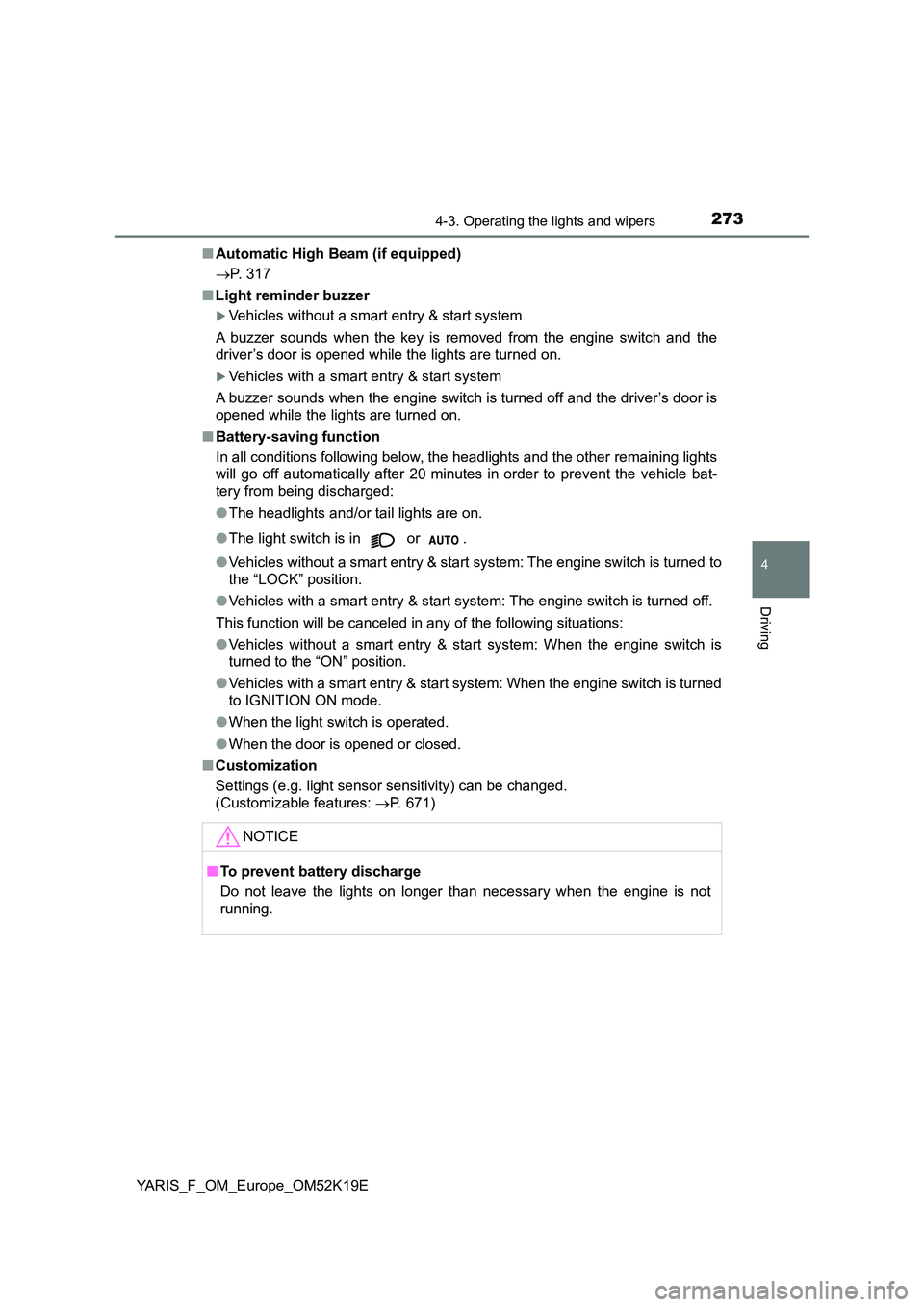
2734-3. Operating the lights and wipers
4
Driving
YARIS_F_OM_Europe_OM52K19E
■ Automatic High Beam (if equipped)
P. 317
■ Light reminder buzzer
Vehicles without a smart entry & start system
A buzzer sounds when the key is removed from the engine switch and the
driver’s door is opened while the lights are turned on.
Vehicles with a smart entry & start system
A buzzer sounds when the engine switch is turned off and the driver’s door is
opened while the lights are turned on.
■ Battery-saving function
In all conditions following below, the headlights and the other remaining lights
will go off automatically after 20 minutes in order to prevent the vehicle bat-
tery from being discharged:
● The headlights and/or tail lights are on.
● The light switch is in or .
● Vehicles without a smart entry & start system: The engine switch is turned to
the “LOCK” position.
● Vehicles with a smart entry & start system: The engine switch is turned off.
This function will be canceled in any of the following situations:
● Vehicles without a smart entry & start system: When the engine switch is
turned to the “ON” position.
● Vehicles with a smart entry & start system: When the engine switch is turned
to IGNITION ON mode.
● When the light switch is operated.
● When the door is opened or closed.
■ Customization
Settings (e.g. light sensor sensitivity) can be changed.
(Customizable features: P. 671)
NOTICE
■To prevent battery discharge
Do not leave the lights on longer than necessary when the engine is not
running.
Page 300 of 700
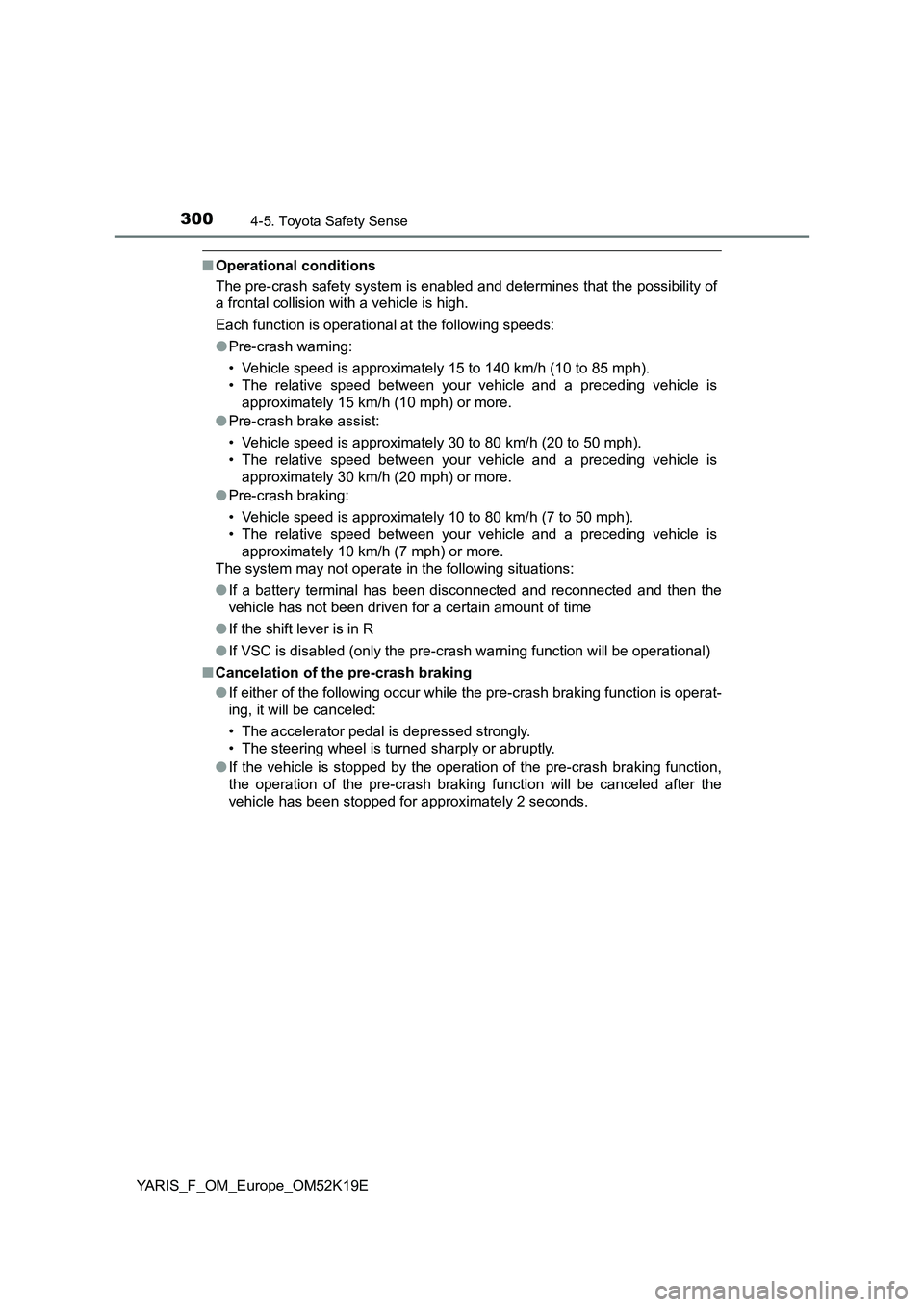
3004-5. Toyota Safety Sense
YARIS_F_OM_Europe_OM52K19E
■Operational conditions
The pre-crash safety system is enabled and determines that the possibility of
a frontal collision with a vehicle is high.
Each function is operational at the following speeds:
● Pre-crash warning:
• Vehicle speed is approximately 15 to 140 km/h (10 to 85 mph).
• The relative speed between your vehicle and a preceding vehicle is
approximately 15 km/h (10 mph) or more.
● Pre-crash brake assist:
• Vehicle speed is approximately 30 to 80 km/h (20 to 50 mph).
• The relative speed between your vehicle and a preceding vehicle is
approximately 30 km/h (20 mph) or more.
● Pre-crash braking:
• Vehicle speed is approximately 10 to 80 km/h (7 to 50 mph).
• The relative speed between your vehicle and a preceding vehicle is
approximately 10 km/h (7 mph) or more.
The system may not operate in the following situations:
● If a battery terminal has been disconnected and reconnected and then the
vehicle has not been driven for a certain amount of time
● If the shift lever is in R
● If VSC is disabled (only the pre-crash warning function will be operational)
■ Cancelation of the pre-crash braking
● If either of the following occur while the pre-crash braking function is operat-
ing, it will be canceled:
• The accelerator pedal is depressed strongly.
• The steering wheel is turned sharply or abruptly.
● If the vehicle is stopped by the operation of the pre-crash braking function,
the operation of the pre-crash braki ng function will be canceled after the
vehicle has been stopped for approximately 2 seconds.
Page 340 of 700

3404-6. Using the driving support systems
YARIS_F_OM_Europe_OM52K19E
■Operating conditions
● The Stop & Start system is operational when all of the following conditions
are met:
• The engine is adequately warmed up.
• The battery is sufficiently charged.
• The driver’s door is closed.
• The driver’s seat belt is fastened.
• The hood is closed.
• The outside temperature is -5°C (23°F) or higher.
• The accelerator pedal is not being depressed.
• Vehicles with a Multidrive: The brake pedal is firmly depressed.
• Vehicles with a Multidrive: The shift lever is not in R.
• Vehicles with a manual transmission: The clutch pedal is not being
depressed.
• Vehicles with a manual transmission: The shift lever is in N.
● In the following circumstances the engine may not be stopped by the Stop &
Start system. This is not a malfunction of the Stop & Start system.
• Engine coolant temperature or transmi ssion fluid temperature is too low
or too high.
• The outside temperature is extremely low.
• The air conditioning system is being used when the outside temperature
is high or low.
• The air conditioning system is being used when the vehicle interior tem-
perature is extremely high such as after the vehicle was parked under the
hot sun.
• Vehicles with an automatic air conditioning system: The windshield
defogger is being used.
• The battery is undergoing a periodic recharge.
• The battery is not sufficiently charged, such as if the vehicle has been
parked for a long time and the battery charge has decreased, the electric
load is large, the battery fluid temperature is excessively low or the bat-
tery has deteriorated.
• The battery fluid temperature is extremely low or high.
• Due to traffic or other circumstances the vehicle is stopped repeatedly,
resulting in the amount of time the engine is stopped by the Stop & Start
system to become excessively high.
• The driver’s seat belt is unfastened.
• The driver’s door is opened.
• The hood is opened.
• The vehicle is stopped on a steep hill.
• The brake booster vacuum is low.
• A large amount of electricity is being used.
• At high altitude.
When the above conditions improve, the Stop & Start system will stop and
restart the engine from the next time the vehicle is stopped.
Page 341 of 700

3414-6. Using the driving support systems
4
Driving
YARIS_F_OM_Europe_OM52K19E
● In the following situations, the engine may start even without the brake
pedal being released (Multidrive) or clutch pedal being depressed (manual
transmission).
• The brake pedal is pumped or strongly depressed.
• The air conditioning system is being used or turned on.
• Vehicles with an automatic air conditioning system: The windshield
defogger is turned on.
• The battery is not sufficiently charged.
• The vehicle starts to roll on an incline.
• Vehicles with a Multidrive: The hood is opened when the shift lever is in N
or P.
• Vehicles with a Multidrive: The shift lever is shifted into a position other
than N or P.
• The accelerator pedal is depressed.
• A large amount of electricity is being used.
• The driver’s door is opened.
• The driver’s seat belt is unfastened.
● In the following situations, it may take longer than normal for the Stop & Start
system to activate.
• The battery is discharged.
• After the battery terminals have been disconnected and reconnected
after a battery replacement, etc.
• The engine coolant temperature is low.
■ Automatic reactivation of the Stop & Start system
Vehicles without a smart entry & start system
Even if the Stop & Start system is disabled by the Stop & Start cancel switch,
it will be automatically re-enabled once the engine switch is turned to the
“LOCK” position then to the “START” position.
Vehicles with a smart entry & start system
Even if the Stop & Start system is disabled by the Stop & Start cancel switch,
it will be automatically re-enabled once the engine switch is turned off then
the engine is started.
Page 343 of 700
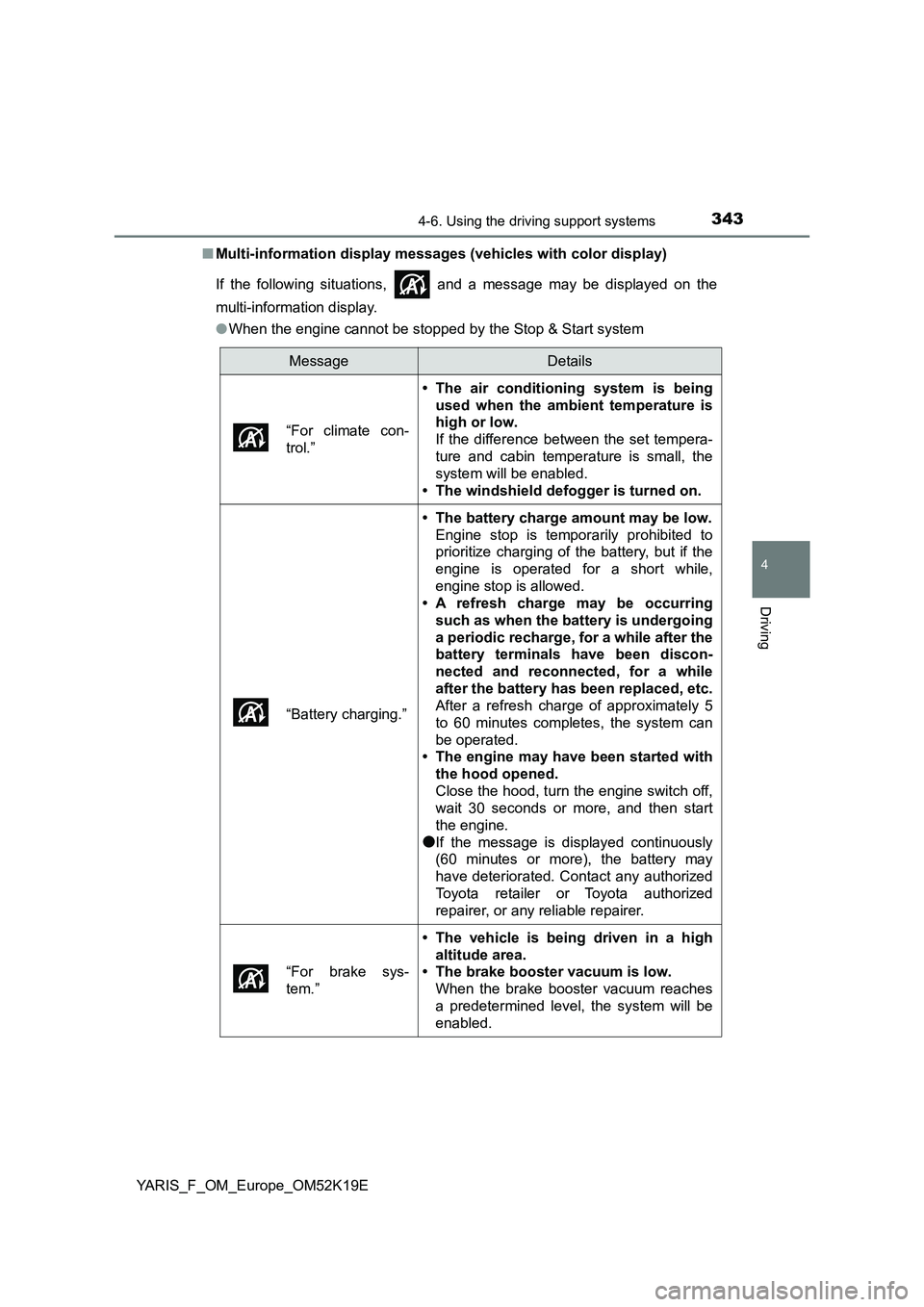
3434-6. Using the driving support systems
4
Driving
YARIS_F_OM_Europe_OM52K19E
■ Multi-information display messages (vehicles with color display)
If the following situations, and a message may be displayed on the
multi-information display.
● When the engine cannot be stopped by the Stop & Start system
MessageDetails
“For climate con-
trol.”
• The air conditioning system is being
used when the ambient temperature is
high or low.
If the difference between the set tempera-
ture and cabin temperature is small, the
system will be enabled.
• The windshield defogger is turned on.
“Battery charging.”
• The battery charge amount may be low.
Engine stop is temporarily prohibited to
prioritize charging of the battery, but if the
engine is operated for a short while,
engine stop is allowed.
• A refresh charge may be occurring
such as when the battery is undergoing
a periodic recharge, for a while after the
battery terminals have been discon-
nected and reconnected, for a while
after the battery has been replaced, etc.
After a refresh charge of approximately 5
to 60 minutes completes, the system can
be operated.
• The engine may have been started with
the hood opened.
Close the hood, turn the engine switch off,
wait 30 seconds or more, and then start
the engine.
●If the message is displayed continuously
(60 minutes or more), the battery may
have deteriorated. Contact any authorized
Toyota retailer or Toyota authorized
repairer, or any reliable repairer.
“For brake sys-
tem.”
• The vehicle is being driven in a high
altitude area.
• The brake booster vacuum is low.
When the brake booster vacuum reaches
a predetermined level, the system will be
enabled.
Page 344 of 700
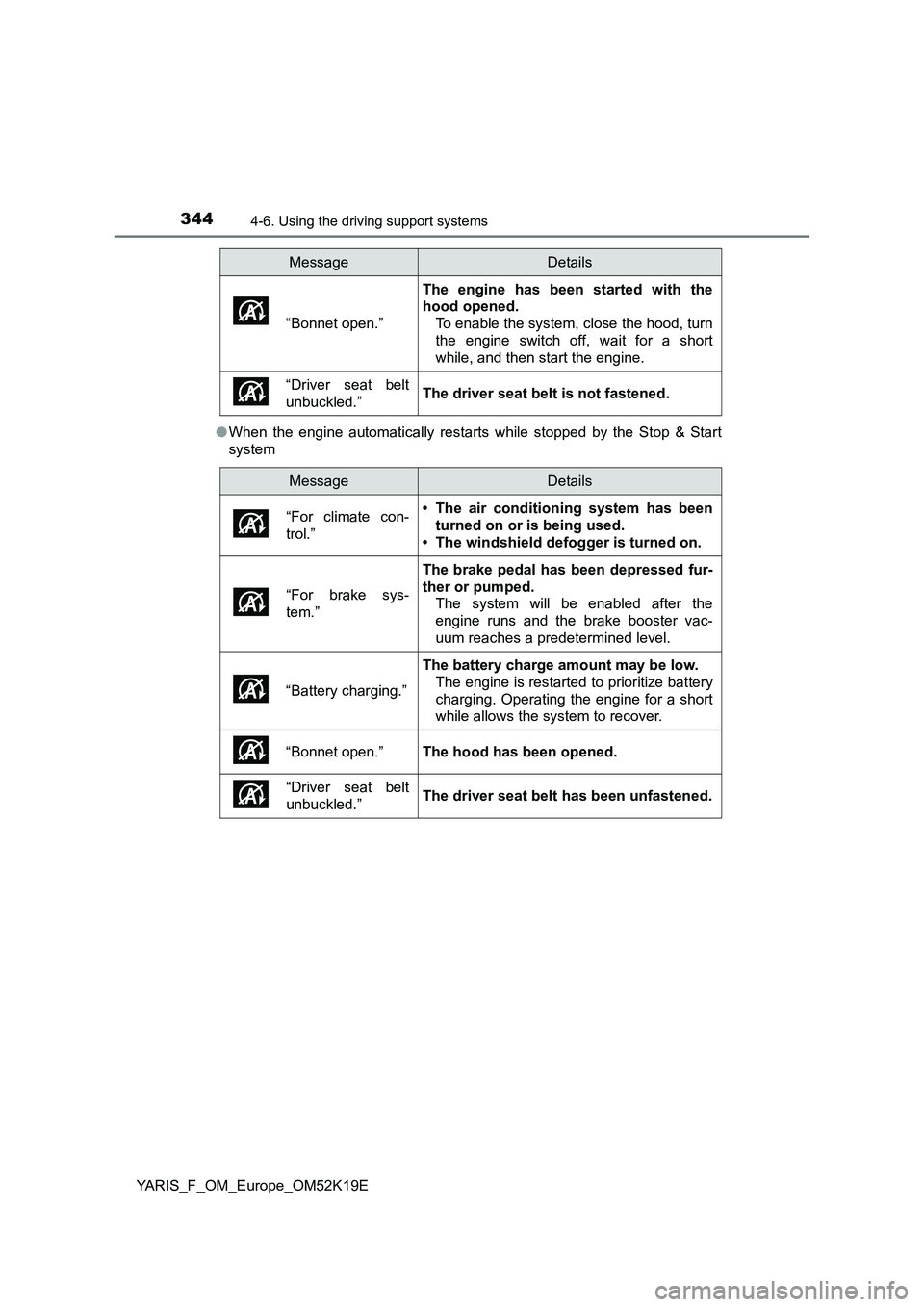
3444-6. Using the driving support systems
YARIS_F_OM_Europe_OM52K19E
● When the engine automatically restarts while stopped by the Stop & Start
system
“Bonnet open.”
The engine has been started with the
hood opened.
To enable the system, close the hood, turn
the engine switch off, wait for a short
while, and then start the engine.
“Driver seat belt
unbuckled.”The driver seat belt is not fastened.
MessageDetails
MessageDetails
“For climate con-
trol.”
• The air conditioning system has been
turned on or is being used.
• The windshield defogger is turned on.
“For brake sys-
tem.”
The brake pedal has been depressed fur-
ther or pumped.
The system will be enabled after the
engine runs and the brake booster vac-
uum reaches a predetermined level.
“Battery charging.”
The battery charge amount may be low.
The engine is restarted to prioritize battery
charging. Operating the engine for a short
while allows the system to recover.
“Bonnet open.”The hood has been opened.
“Driver seat belt
unbuckled.”The driver seat belt has been unfastened.
Page 346 of 700
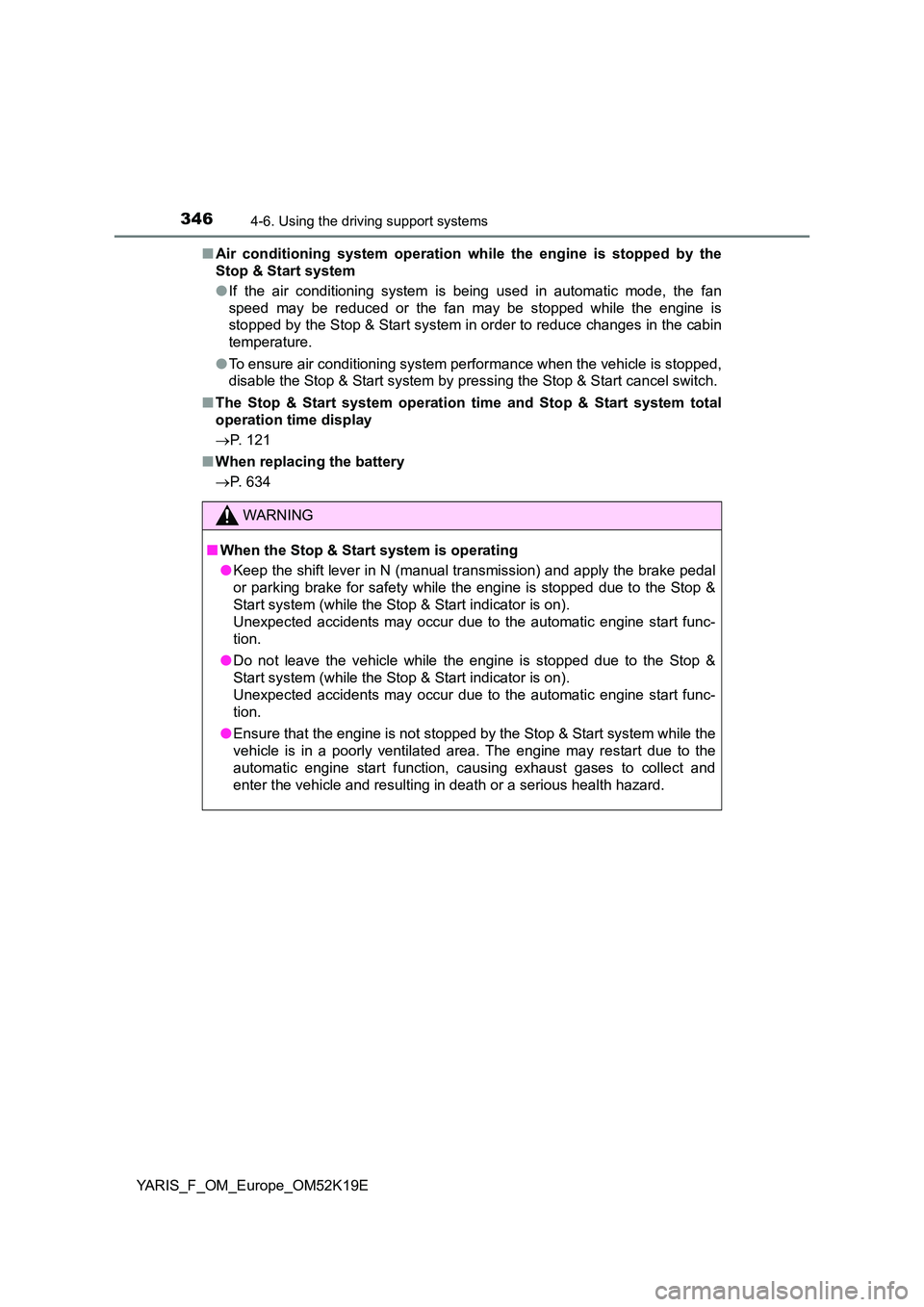
3464-6. Using the driving support systems
YARIS_F_OM_Europe_OM52K19E
■ Air conditioning system operation while the engine is stopped by the
Stop & Start system
● If the air conditioning system is being used in automatic mode, the fan
speed may be reduced or the fan may be stopped while the engine is
stopped by the Stop & Start system in order to reduce changes in the cabin
temperature.
● To ensure air conditioning system performance when the vehicle is stopped,
disable the Stop & Start system by pressing the Stop & Start cancel switch.
■ The Stop & Start system operation time and Stop & Start system total
operation time display
P. 121
■ When replacing the battery
P. 634
WARNING
■When the Stop & Start system is operating
● Keep the shift lever in N (manual transmission) and apply the brake pedal
or parking brake for safety while the engine is stopped due to the Stop &
Start system (while the Stop & Start indicator is on).
Unexpected accidents may occur due to the automatic engine start func-
tion.
● Do not leave the vehicle while the engine is stopped due to the Stop &
Start system (while the Stop & Start indicator is on).
Unexpected accidents may occur due to the automatic engine start func-
tion.
● Ensure that the engine is not stopped by the Stop & Start system while the
vehicle is in a poorly ventilated area. The engine may restart due to the
automatic engine start function, causing exhaust gases to collect and
enter the vehicle and resulting in death or a serious health hazard.
Page 355 of 700

355
4
4-7. Driving tips
Driving
YARIS_F_OM_Europe_OM52K19E
Winter driving tips
●Use fluids that are appropriate to the prevailing outside tempera-
tures.
• Engine oil
• Engine coolant
• Washer fluid
● Have a service technician inspect the condition of the battery.
● Have the vehicle fitted with four snow tires or purchase a set of tire
chains for the front tires.
Ensure that all tires are the specified size and brand, and that chains
match the size of the tires.
Perform the following according to the driving conditions:
● Do not try to forcibly open a window or move a wiper that is frozen.
Pour warm water over the frozen area to melt the ice. Wipe away
the water immediately to prevent it from freezing.
● To ensure proper operation of the climate control system fan,
remove any snow that has accumulated on the air inlet vents in
front of the windshield.
● Check for and remove any excess ice or snow that may have accu-
mulated on the exterior lights, vehicle’s roof, chassis, around the
tires or on the brakes.
● Remove any snow or mud from the bottom of your shoes before
getting in the vehicle.
Carry out the necessary preparations and inspections before
driving the vehicle in winter. Always drive the vehicle in a man-
ner appropriate to the prevailing weather conditions.
Preparation for winter
Before driving the vehicle